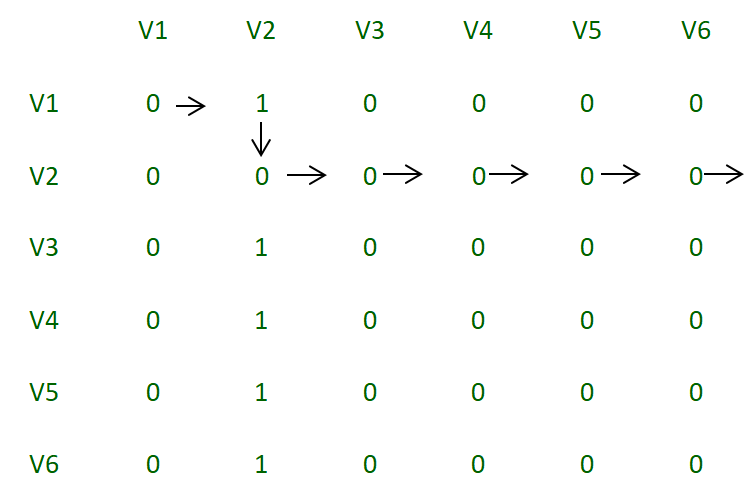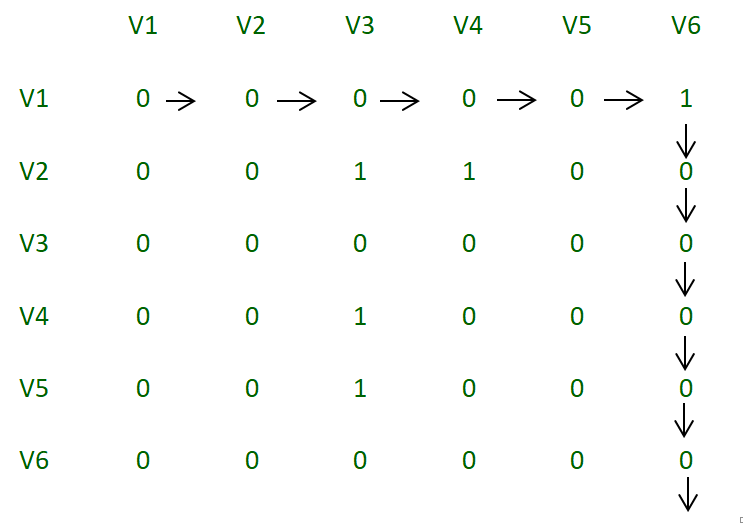判断有向图中是否存在通用汇
确定有向图中是否存在通用接收器。通用水槽是没有从它发出的边的顶点,并且所有其他顶点都有朝向水槽的边。
Input :
v1 -> v2 (implies vertex 1 is connected to vertex 2)
v3 -> v2
v4 -> v2
v5 -> v2
v6 -> v2
Output :
Sink found at vertex 2
Input :
v1 -> v6
v2 -> v3
v2 -> v4
v4 -> v3
v5 -> v3
Output :
No Sink我们尝试在O(n)时间内消除 n – 1 个非汇顶点,并检查剩余顶点的汇属性。
为了消除顶点,我们检查邻接矩阵中的特定索引(A[i][j])是1还是0。如果是0,则表示索引j对应的顶点不能是sink。如果 index 为 1,则表示 i 对应的顶点不能是 sink。我们以这种方式不断增加 i 和 j,直到 i 或 j 超过顶点数。
使用这种方法,我们可以只对一个顶点而不是所有 n 个顶点执行通用接收器测试。假设我们只剩下顶点 i。
我们现在检查第 i 行是否只有 0,以及第 j 行是否只有 1,除了 A[i][i],它将为 0。
插图 :
v1 -> v2
v3 -> v2
v4 -> v2
v5 -> v2
v6 -> v2
We can visualize the adjacency matrix for
the above as follows:
0 1 0 0 0 0
0 0 0 0 0 0
0 1 0 0 0 0
0 1 0 0 0 0
0 1 0 0 0 0 我们观察到顶点 2 没有任何发射边,并且每个其他顶点在顶点 2 中都有一条边。在 A[0][0] (A[i][j]) 处,我们遇到一个 0,所以我们递增j 和下一个
看看 A[0][1]。这里我们遇到一个 1。所以我们必须将 i 增加 1。A[1][1] 为 0,所以我们不断增加 j。我们注意到 A[1][2], A[1][3].. 等都是 0,所以 j 将超过
顶点数(本例中为 6 个)。我们现在检查第 i 行和第 i 列的 sink 属性。第 i 行必须完全为 0,第 i 列必须完全为 1,但索引 A[i][i] 除外

邻接矩阵
第二个例子:
v1 -> v6
v2 -> v3
v2 -> v4
v4 -> v3
v5 -> v3
We can visualize the adjacency matrix
for the above as follows:
0 0 0 0 0 1
0 0 1 1 0 0
0 0 0 0 0 0
0 0 1 0 0 0
0 0 1 0 0 0
0 0 0 0 0 0在这个例子中,我们观察到在第 1 行中,除了最后一列之外,每个元素都是 0。所以我们将递增 j 直到达到 1。当我们达到 1 时,我们递增 i
A[i][j]的值为0。如果i超过顶点数,就不可能有sink,这种情况下,i会超过顶点数。

邻接矩阵
Java
// Java program to find whether a universal sink
// exists in a directed graph
import java.io.*;
import java.util.*;
class graph
{
int vertices;
int[][] adjacency_matrix;
// constructor to initialize number of vertices and
// size of adjacency matrix
public graph(int vertices)
{
this.vertices = vertices;
adjacency_matrix = new int[vertices][vertices];
}
public void insert(int source, int destination)
{
// make adjacency_matrix[i][j] = 1 if there is
// an edge from i to j
adjacency_matrix[destination-1] = 1;
}
public boolean issink(int i)
{
for (int j = 0 ; j < vertices ; j++)
{
// if any element in the row i is 1, it means
// that there is an edge emanating from the
// vertex, which means it cannot be a sink
if (adjacency_matrix[i][j] == 1)
return false;
// if any element other than i in the column
// i is 0, it means that there is no edge from
// that vertex to the vertex we are testing
// and hence it cannot be a sink
if (adjacency_matrix[j][i] == 0 && j != i)
return false;
}
//if none of the checks fails, return true
return true;
}
// we will eliminate n-1 non sink vertices so that
// we have to check for only one vertex instead of
// all n vertices
public int eliminate()
{
int i = 0, j = 0;
while (i < vertices && j < vertices)
{
// If the index is 1, increment the row we are
// checking by 1
// else increment the column
if (adjacency_matrix[i][j] == 1)
i = i + 1;
else
j = j + 1;
}
// If i exceeds the number of vertices, it
// means that there is no valid vertex in
// the given vertices that can be a sink
if (i > vertices)
return -1;
else if (!issink(i))
return -1;
else return i;
}
}
public class Sink
{
public static void main(String[] args)throws IOException
{
int number_of_vertices = 6;
int number_of_edges = 5;
graph g = new graph(number_of_vertices);
/*
//input set 1
g.insert(1, 6);
g.insert(2, 6);
g.insert(3, 6);
g.insert(4, 6);
g.insert(5, 6);
*/
//input set 2
g.insert(1, 6);
g.insert(2, 3);
g.insert(2, 4);
g.insert(4, 3);
g.insert(5, 3);
int vertex = g.eliminate();
// returns 0 based indexing of vertex. returns
// -1 if no sink exits.
// returns the vertex number-1 if sink is found
if (vertex >= 0)
System.out.println("Sink found at vertex "
+ (vertex + 1));
else
System.out.println("No Sink");
}
}Python3
# Python3 program to find whether a
# universal sink exists in a directed graph
class Graph:
# constructor to initialize number of
# vertices and size of adjacency matrix
def __init__(self, vertices):
self.vertices = vertices
self.adjacency_matrix = [[0 for i in range(vertices)]
for j in range(vertices)]
def insert(self, s, destination):
# make adjacency_matrix[i][j] = 1
# if there is an edge from i to j
self.adjacency_matrix[s - 1][destination - 1] = 1
def issink(self, i):
for j in range(self.vertices):
# if any element in the row i is 1, it means
# that there is an edge emanating from the
# vertex, which means it cannot be a sink
if self.adjacency_matrix[i][j] == 1:
return False
# if any element other than i in the column
# i is 0, it means that there is no edge from
# that vertex to the vertex we are testing
# and hence it cannot be a sink
if self.adjacency_matrix[j][i] == 0 and j != i:
return False
# if none of the checks fails, return true
return True
# we will eliminate n-1 non sink vertices so that
# we have to check for only one vertex instead of
# all n vertices
def eliminate(self):
i = 0
j = 0
while i < self.vertices and j < self.vertices:
# If the index is 1, increment the row
# we are checking by 1
# else increment the column
if self.adjacency_matrix[i][j] == 1:
i += 1
else:
j += 1
# If i exceeds the number of vertices, it
# means that there is no valid vertex in
# the given vertices that can be a sink
if i > self.vertices:
return -1
else if self.issink(i) is False:
return -1
else:
return i
# Driver Code
if __name__ == "__main__":
number_of_vertices = 6
number_of_edges = 5
g = Graph(number_of_vertices)
# input set 1
# g.insert(1, 6)
# g.insert(2, 6)
# g.insert(3, 6)
# g.insert(4, 6)
# g.insert(5, 6)
# input set 2
g.insert(1, 6)
g.insert(2, 3)
g.insert(2, 4)
g.insert(4, 3)
g.insert(5, 3)
vertex = g.eliminate()
# returns 0 based indexing of vertex.
# returns -1 if no sink exits.
# returns the vertex number-1 if sink is found
if vertex >= 0:
print("Sink found at vertex %d" % (vertex + 1))
else:
print("No Sink")
# This code is contributed by
# sanjeev2552C#
// C# program to find whether a universal sink
// exists in a directed graph
using System;
using System.Collections.Generic;
class graph
{
int vertices, itr;
int[,] adjacency_matrix;
// constructor to initialize number of vertices and
// size of adjacency matrix
public graph(int vertices)
{
this.vertices = vertices;
adjacency_matrix = new int[vertices, vertices];
}
public void insert(int source, int destination)
{
// make adjacency_matrix[i,j] = 1 if there is
// an edge from i to j
adjacency_matrix = 1;
}
public bool issink(int i)
{
for (int j = 0 ; j < vertices ; j++)
{
// if any element in the row i is 1, it means
// that there is an edge emanating from the
// vertex, which means it cannot be a sink
if (adjacency_matrix[i, j] == 1)
return false;
// if any element other than i in the column
// i is 0, it means that there is no edge from
// that vertex to the vertex we are testing
// and hence it cannot be a sink
if (adjacency_matrix[j, i] == 0 && j != i)
return false;
}
//if none of the checks fails, return true
return true;
}
// we will eliminate n-1 non sink vertices so that
// we have to check for only one vertex instead of
// all n vertices
public int eliminate()
{
int i = 0, j = 0;
while (i < vertices && j < vertices)
{
// If the index is 1, increment the row we are
// checking by 1
// else increment the column
if (adjacency_matrix[i, j] == 1)
i = i + 1;
else
j = j + 1;
}
// If i exceeds the number of vertices, it
// means that there is no valid vertex in
// the given vertices that can be a sink
if (i > vertices)
return -1;
else if (!issink(i))
return -1;
else return i;
}
}
public class Sink
{
public static void Main(String[] args)
{
int number_of_vertices = 6;
graph g = new graph(number_of_vertices);
/*
//input set 1
g.insert(1, 6);
g.insert(2, 6);
g.insert(3, 6);
g.insert(4, 6);
g.insert(5, 6);
*/
//input set 2
g.insert(1, 6);
g.insert(2, 3);
g.insert(2, 4);
g.insert(4, 3);
g.insert(5, 3);
int vertex = g.eliminate();
// returns 0 based indexing of vertex. returns
// -1 if no sink exits.
// returns the vertex number-1 if sink is found
if (vertex >= 0)
Console.WriteLine("Sink found at vertex "
+ (vertex + 1));
else
Console.WriteLine("No Sink");
}
}
// This code is contributed by Rajput-Ji输出:
input set 1:
Sink found at vertex 6
input set 2:
No Sink